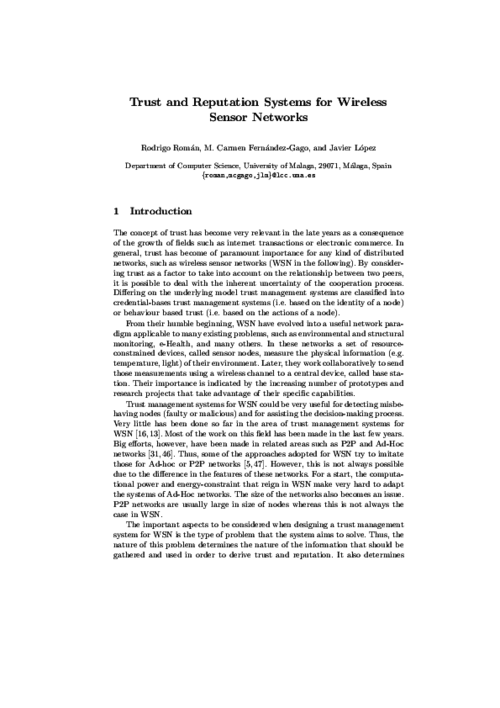 ] Type Year
] Type Year Digital Home Networking, R. Carbou, E. Exposito, R. Roman, and M. Diaz Eds., no. 7130, John Wiley & Sons Inc., pp. 60-96, 2011.
|
"Location Privacy in Wireless Sensor Networks", CRC Series in Security, Privacy and Trust, Taylor & Francis, 2016.  |  |
Foundations of Security Analysis and Design VII, vol. 8604, no. LNCS, Springer, pp. 244-282, 2014. DOI
Abstract
Privacy preservation is gaining popularity in Wireless Sensor Network (WSNs) due to its adoption in everyday scenarios. There are a number of research papers in this area many of which concentrate on the location privacy problem. In this paper we review and categorise these solutions based on the information available to the adversary and his capabilities. But first we analyse whether traditional anonymous communication systems conform to the original requirements of location privacy in sensor networks. Finally, we present and discuss a number of challenges and future trends that demand further attention from the research community.

XVIII Jornadas Telecom I+D, October, 2008.
Abstract
Los sistemas distribuidos en dispositivos embebidos representan un nuevo reto en el desarrollo de software. Estos sistemas han supuesto una importante revolución en el paradigma de la computación distribuida donde se intenta fragmentar un problema grande en múltiples problemas más pequeños. El nuevo escenario tiende entonces hacia sistemas en los cuales todos los elementos de la red se consideran iguales y los mecanismos de comunicación estãn basados en redes ad-hoc que se forman dinámicamente. De esta forma cualquier usuario de la red (en realidad cualquier elemento, hasta el más simple dispositivo) adquiere valor, a mayor colaboración, mayor éxito del sistema. Sin embargo, desde el punto de vista de la seguridad, estos sistemas son extremadamente vulnerables. En este artículo se presenta SMEPP, un middleware diseñado especialmente para sistemas P2P incluyendo aspectos de seguridad. SMEPP está diseñado para poder ser ejecutado en un amplio rango de dispositivos (desde redes de sensores hasta PC), y trata de facilitar el desarrollo de aplicaciones ocultando los detalles de la plataforma y otros aspectos tales como escalabilidad, adaptabilidad e interoperabilidad. Además el artículo presenta dos aplicaciones de alto nivel que utilizando este middleware pasan a ser más personales, más sociales y más baratas, haciendo que todos los usuarios de la red cobren mayor importancia.
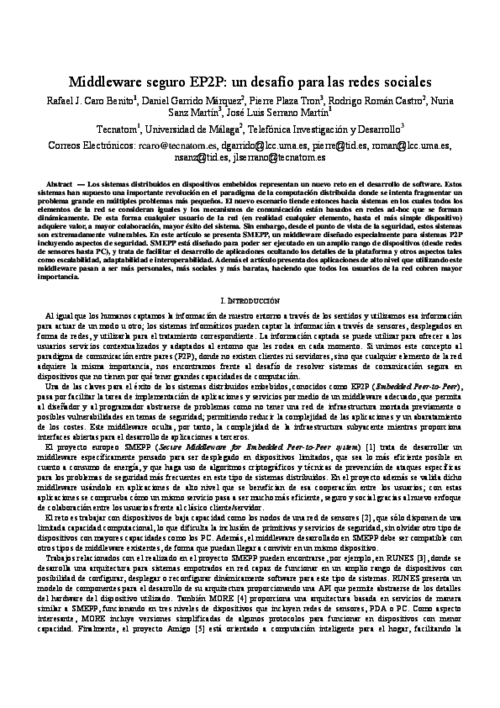
XI Jornadas de Ingeniería Telemática (JITEL 2013), J. E. Díaz Verdejo, J. Navarro Ortiz, and J. J. Ramos Muñoz Eds., Asociación de Telemática, pp. 481-486, Oct 2013.
Abstract
La estación base es el elemento más importante en un red de sensores y, por tanto, es necesario evitar que un atacante pueda hacerse con el control de este valioso dispositivo. Para ello, el atacante puede valerse tanto de técnicas de análisis de tráfico como de la captura de nodos. En este trabajo presentamos un esquema que consta de dos fases, la primera está dedicada a homogeneizar los patrones de tráfico y la segunda encargada de perturbar las tablas de rutas de los nodos. Ambas fases permiten mantener a la estación base fuera del alcance del atacante con un coste computacional insignificante y un consumo energético moderado. La validez de nuestro esquema ha sido validada analíticamente y a través de numerosas simulaciones.
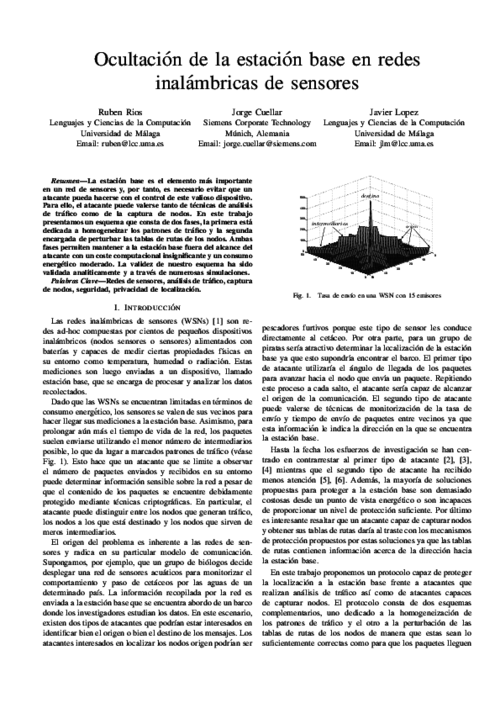
Information Security Practice and Experience (ISPEC 2014), vol. 8434, Springer, pp. 15-27, 05/2014. DOI
Abstract
Wireless sensor networks (WSNs) are exposed to many different types of attacks. Among these, the most devastating attack is to compromise or destroy the base station since all communications are addressed exclusively to it. Moreover, this feature can be exploited by a passive adversary to determine the location of this critical device. This receiver-location privacy problem can be reduced by hindering traffic analysis but the adversary may still obtain location information by capturing a subset of sensor nodes in the field. This paper addresses, for the first time, these two problems together in a single solution
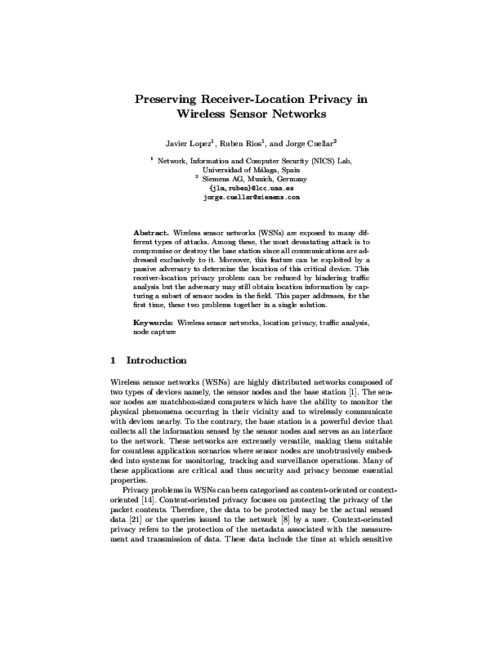
Information Sciences, vol. 321, Elsevier, pp. 205 - 223, 07/2015. DOI
Abstract
Wireless sensor networks (WSNs) are continually exposed to many types of attacks. Among these, the attacks targeted at the base station are the most devastating ones since this essential device processes and analyses all traffic generated in the network. Moreover, this feature can be exploited by a passive adversary to determine its location based on traffic analysis. This receiver-location privacy problem can be reduced by altering the traffic pattern of the network but the adversary may still be able to reach the base station if he gains access to the routing tables of a number of sensor nodes. In this paper we present HISP-NC (Homogenous Injection for Sink Privacy with Node Compromise protection), a receiver-location privacy solution that consists of two complementary schemes which protect the location of the base station in the presence of traffic analysis and node compromise attacks. The HISP-NC data transmission protocol prevents traffic analysis by probabilistically hiding the flow of real traffic with moderate amounts of fake traffic. Moreover, HISP-NC includes a perturbation mechanism that modifies the routing tables of the nodes to introduce some level of uncertainty in attackers capable of retrieving the routing information from the nodes. Our scheme is validated both analytically and experimentally through extensive simulations.
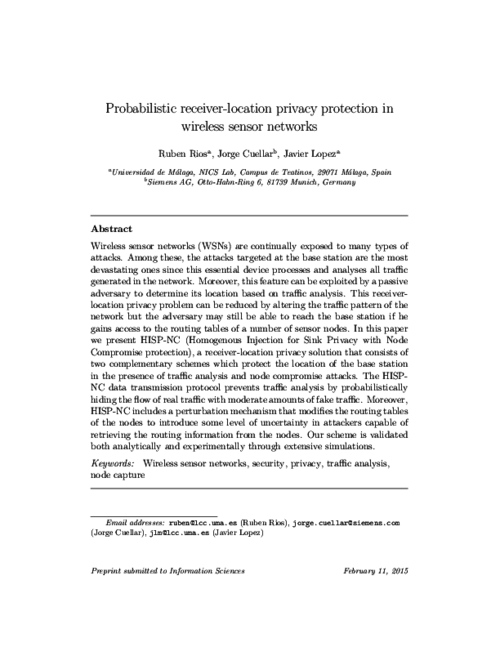
17th European Symposium on Research in Computer Security (ESORICS 2012), S. Foresti, M. Yung, and F. Martinelli Eds., LNCS 7459, Springer, pp. 163-180, Sep 2012. DOI
Abstract
The singular communication model in wireless sensor networks (WSNs) originate pronounced traffic patterns that allow a local observer to deduce the location of the base station, which must be kept secret for both strategical and security reasons. In this work we present a new receiver-location privacy solution called HISP (Homogenous Injection for Sink Privacy). Our scheme is based on the idea of hiding the flow of real traffic by carefully injecting fake traffic to homogenize the transmissions from a node to its neighbors. This process is guided by a lightweight probabilistic approach ensuring that the adversary cannot decide with sufficient precision in which direction to move while maintaining a moderate amount of fake traffic. Our system is both validated analytically and experimentally through simulations.
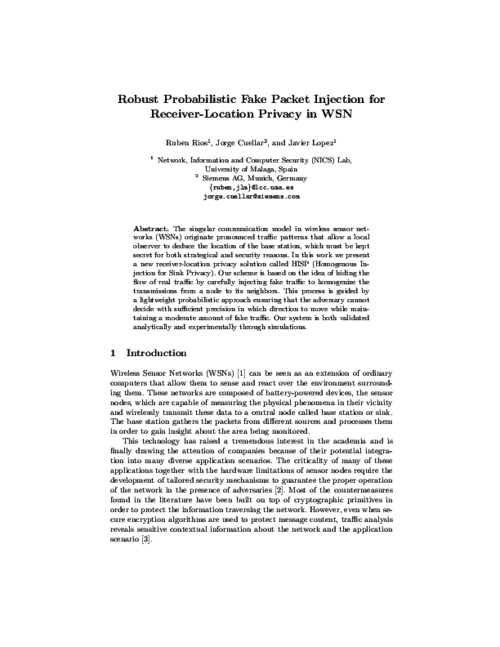
Computers & Security, vol. 31, no. 38, Elsevier, pp. 956–966, Nov 2012. DOI
Abstract
Key management in wireless sensor networks (WSN) is an active research topic. Due to the fact that a large number of key management schemes (KMS) have been proposed in the literature, it is not easy for a sensor network designer to know exactly which KMS best fits in a particular WSN application. In this article, we offer a comprehensive review on how the application requirements and the properties of various key management schemes influence each other. Based on this review, we show that the KMS plays a critical role in determining the security performance of a WSN network with given application requirements. We also develop a method that allows the network designers to select the most suitable KMS for a specific WSN network setting. In addition, the article also addresses the issues on the current state-of-the-art research on the KMS for homogeneous (i.e. non-hierarchical) networks to provide solutions for establishing link-layer keys in various WSN applications and scenarios.
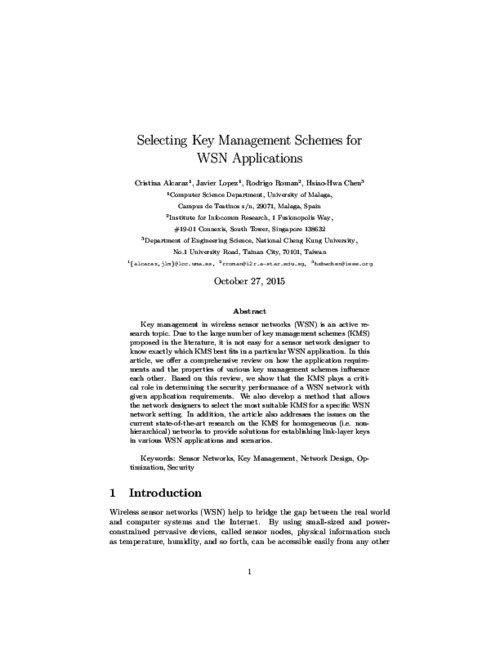
5th International Symposium on Security and Multimodality in Pervasive Environments (SMPE’11), IEEE, March, 2011. DOI
Abstract
Key Management Schemes (KMS) are a very important security mechanism for Wireless Sensor Networks (WSN), as they are used to manage the credentials (i.e. secret keys) that are needed by the security primitives. There is a large number of available KMS protocols in the literature, but it is not clear what should network designers do to choose the most suitable protocol for the needs of their applications. In this paper, we consider that given a certain set of application requirements, the network designer can check which properties comply with those requirements and select the KMS protocols that contains those particular properties. Therefore, we study the relationship between requirements and properties, and we provide a web tool, the SenseKey tool, that can be used to automatically obtain an optimal set of KMS protocols.
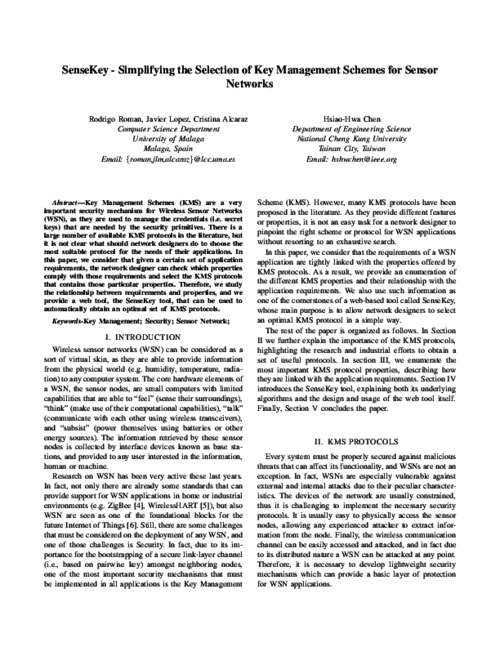
ICT Mobile and Wireless Communications Summit (ICT-MobileSummit’09), June, 2009.
Abstract
The increasing presence of embedded devices with internet access capabilities constitutes a new challenge in software development. These devices are now cooperating in a distributed manner towards what has been called as "Internet of Things". In this new scenario the client-server model is sometimes not adequate and dynamic ad-hoc networks are more common than before. However, security poses as a hard issue as these systems are extremely vulnerable. In this paper, we introduce SMEPP project, which aims at developing a middleware designed for P2P systems with a special focus on embedded devices and security. SMEPP is designed to be deployed in a wide range of devices. It tries to ease the development of applications hiding platforms details and other aspects such as scalability, adaptability and interoperability. A full implementation of this middleware is already available that incorporates security features specially designed for low-resource devices. Moreover, we describe two business applications being developed using this middleware in the context of "Digital Home" and "Environmental Monitoring in Industrial Environments".
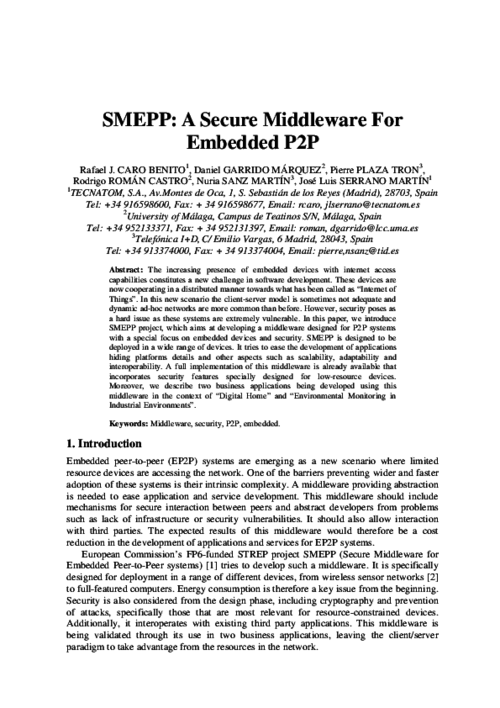
Security and Privacy in Mobile and Wireless Networking, S. Gritzalis, T. Karygiannis, and C. Skianis Eds., Troubador Publishing Ltd, pp. 105-128, 2009.
Abstract
The concept of trust has become very relevant in the late years as a consequence of the growth of fields such as internet transactions or electronic commerce. In general, trust has become of paramount importance for any kind of distributed networks, such as wireless sensor networks (WSN in the following). In this chapter of the book, we try to give a general overview of the state of the art on trust management systems for WSN and also try to identify the main features of the architectures of these trust management systems.
